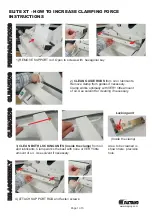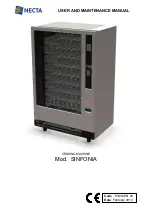
GENERAL
1. The Protector™ is designed to allow the intermediate
gear to slip on an excessive overload. An overload is
indicated when the hoist will not raise the load. Also,
some clutching noise may be heard if the hoist is loaded
beyond rated capacity. Should this occur, immediately
release the up
control to stop the operation of the
hoist. At this point, the load should be reduced to the
rated hoist capacity or the hoist should be replaced with
one of the proper capacity. When the excessive load is
removed, normal hoist operation is automatically restored.
CAUTION: The Protector™ is susceptible to over-
heating and wear when slipped for extended peri-
ods. Under no circumstance should the clutch be
allowed to slip for more than a few seconds.
Due to the above, a hoist equipped with a Protector
™
is not
recommended for use in any application where there is a
possibility of adding to an already suspended load to the
point of overload. This includes dumbwaiter (*see below)
installations, containers that are loaded im mid-air, etc.
(*)Refer to limitations on Page i concerning dumbwaiter
applications.
Also, if a Lodestar Hoist with a Protector
™
is used at unusual
extremes of ambient temperatures, above 150°F. (106° C.)or
below 15°F. (-0° C.), changes in lubricant properties may
permit the hoist to raise larger loads than under normal oper-
ating conditions and present possibility of damage or injury.
2. All hoists are equipped with an adjustable screw limit
switch, which automatically stops the hook at any pre-
determined point when either hoisting or lowering.
3. The control station used on two speed hoists is similar to
single speed unit, except that either of two definite
speeds may be selected by the operator in both hoisting
and lowering. Each control when partially depressed
provide SLOW speed and when fully depressed gives
FAST speed. Partial release of control returns hoist to
slow speed, while complete release allows hoist to stop.
Rated lifting speeds are shown on hoist identification
plate. SLOW speed is intended as a means of carefully
controlling or “spotting” the load, although the hoist may
be operated solely at this speed if desired. It is not
necessary to operate in the SLOW speed position as the
hoist will pick up a capacity load at FAST speed from a
standing start. In other words, it is not necessary to
hesitate at the slow position when moving control from
STOP to FAST position or vice versa.
4. If material being handled must be immersed in water,
pickling baths, any liquid, dusty or loose solids, use a
sling chain of ample length so that the hook is always
above the surface. Bearings in the hook block are
shielded only against ordinary atmospheric conditions.
HOIST
1. Before picking up a load, check to see that the hoist is
directly overhead.
2.
WHEN APPLYING A LOAD, IT SHOULD BE DIRECTLY
UNDER HOIST OR TROLLEY. AVOID OFF CENTER
LOADING OF ANY KIND.
±
3. Take up a slack load chain carefully and start load easily
to avoid shock and jerking of hoist load chain. If there is
any evidence of overloading, immediately lower the load
and remove the excess load.
4.
DO NOT
allow the load to swing or twist while hoisting.
5.
DO NOT
allow the load to bear against the hook latch.
HOIST WITH LOW HEADROOM TROLLEY
This unit should be moved by pushing on the suspended
load or by pulling the empty hook. However, the unit can also
be moved by pulling on the control station since an internal
steel cable extends the length of the control cord and is
anchored to the hoist and to the control station.
HOIST WITH MOTOR DRIVEN TROLLEY
This unit should be moved by operating the controls marked
±
(Forward) and
(Reverse) in control station. Unless
altered by the erector, depressing
±
(Forward) control will
move the hoist toward motor housing end. Anticipate the
stopping point and allow trolley to coast to a smooth stop.
Reversing or “plugging” to stop trolley causes overheating of
motor and swaying of load.
SAFETY PROCEDURES
For safety precautions and a list of
DO’S
and
DO NOT’S
for
safe operation of hoists, refer to
page ii
.
1. When preparing to lift a load, be sure that the attachments to
the hook are firmly seated in hook saddle. Avoid off center
loading of any kind, especially loading on the point of
hook.
2. When lifting, raise the load only enough to clear the floor
or support and check to be sure that the attachments to
the hook and load are firmly seated. Continue to lift only
after you are assured the load is free of all obstructions.
3.
DO NOT
load hoist beyond the rated capacity shown on
hoist identification plate or on the hoist motor housing
cover or hoist back frame cover. Overload can cause
immediate failure of some load-carrying part or create a
defect causing subsequent failure at less than rated
capacity. When in doubt, use the next larger capacity of
CM Lodestar Hoist.
4.
DO NOT
use this or any other overhead materials han-
dling equipment for lifting persons.
5. Stand clear of all loads and avoid moving a load over the
heads of other personnel. Warn personnel of your inten-
tion to move a load in their area.
6.
DO NOT
leave the load suspended in the air unattended.
7. Permit only qualified personnel to operate unit.
8.
DO NOT
wrap the load chain around the load and hook
onto itself as a choker chain.
Doing this will result in:
a. The loss of the swivel effect of the hook which could
mean a twisted chain and a jammed lift wheel.
b. The upper limit switch is by-passed and the load
could hit the hoist
c. The chain could be damaged at the hook.
9. On two and three part reeved hoists, check for twists in
the load chain. A twist can occur if the lower hook block
has been capsized between the strands of chain.
Reverse the capsize to remove twist.
±
11
OPERATING INSTRUCTIONS
Содержание CM Hoist
Страница 28: ...24 WIRING DIAGRAMS MODELS A AA B C E F H 110 115 1 50 60 VOLT...
Страница 29: ...25 WIRING DIAGRAMS MODELS A AA B C E F H 220 230 1 50 60 VOLT...
Страница 30: ...26 WIRING DIAGRAMS MODELS A AA B C E F H 220 230 3 50 60 OR 380 415 460 3 50 60 VOLT...
Страница 31: ...27 WIRING DIAGRAMS MODELS A AA B C E F H 220 230 3 50 60 OR 380 415 460 3 50 60 VOLT CSA UNITS...
Страница 32: ...28 WIRING DIAGRAMS MODELS A 2 AA 2 B 2 C 2 E 2 F 2 H 2 220 230 3 50 60 VOLT...
Страница 33: ...29 WIRING DIAGRAMS MODELS A 2 AA 2 B 2 C 2 E 2 F 2 H 2 220 230 3 50 60 VOLT CSA UNITS...
Страница 34: ...30 WIRING DIAGRAMS MODELS A 2 AA 2 B 2 C 2 E 2 F 2 H 2 380 415 460 3 50 60 VOLT...
Страница 35: ...31 WIRING DIAGRAMS MODELS A 2 AA 2 B 2 C 2 E 2 F 2 H 2 380 415 460 3 50 60 VOLT CSA UNITS...
Страница 36: ...32 WIRING DIAGRAMS MODELS A AA B C E F H 550 575 3 50 60 VOLT...
Страница 37: ...33 WIRING DIAGRAMS MODELS A AA B C E F H 550 575 3 50 60 VOLT CSA UNITS...
Страница 38: ...34 WIRING DIAGRAMS MODELS A 2 AA 2 B 2 C 2 E 2 F 2 H 2 550 575 3 50 60 VOLT...
Страница 39: ...35 WIRING DIAGRAMS MODELS A 2 AA 2 B 2 C 2 E 2 F 2 H 2 550 575 3 50 60 VOLT CSA UNITS...
Страница 40: ...36 WIRING DIAGRAMS MODELS J L R RT 110 115 1 50 60 VOLT...
Страница 41: ...37 WIRING DIAGRAMS MODELS J L R RT 220 230 1 50 60 VOLT...
Страница 42: ...38 WIRING DIAGRAMS MODELS J JJ L LL R RR RT RRT 220 230 3 50 OR 380 415 460 3 50 60 VOLT...
Страница 43: ...39 WIRING DIAGRAMS MODELS J JJ L LL R RR RT RRT 220 230 3 50 60 OR 380 415 460 3 50 60 VOLT CSA UNITS...
Страница 44: ...40 WIRING DIAGRAMS MODELS J 2 JJ 2 L 2 LL 2 R 2 RR 2 RT 2 RRT 2 220 230 3 50 60 VOLT...
Страница 45: ...41 WIRING DIAGRAMS MODELS J 2 JJ 2 L 2 LL 2 R 2 RR 2 RT 2 RRT 2 220 230 3 50 50 VOLT CSA UNITS...
Страница 46: ...42 WIRING DIAGRAMS MODELS J 2 JJ 2 L 2 LL 2 R 2 RR 2 RT 2 RRT 2 380 415 460 3 50 60 VOLT...
Страница 47: ...43 WIRING DIAGRAMS MODELS J 2 JJ 2 L 2 LL 2 R 2 RR 2 RT 2 RRT 2 380 415 460 3 50 60 VOLT CSA UNITS...
Страница 48: ...44 WIRING DIAGRAMS MODELS J JJ L LL R RR RT RRT 550 575 3 50 60 VOLT...
Страница 49: ...45 WIRING DIAGRAMS MODELS J JJ L LL R RR RT RRT 550 575 3 50 60 VOLT CSA UNITS...
Страница 50: ...46 WIRING DIAGRAMS MODELS J 2 JJ 2 L 2 LL 2 R 2 RR 2 RT 2 RRT 2 550 575 3 50 60 VOLT...
Страница 51: ...47 WIRING DIAGRAMS MODELS J 2 JJ 2 L 2 LL 2 R 2 RR 2 RT 2 RRT 2 550 575 3 50 60 VOLT CSA UNITS...
Страница 57: ...53 Notes...
Страница 62: ...58 LODESTAR LOWER HOOK BLOCK ASSEMBLY...
Страница 89: ...85 NOTES...
Страница 93: ...89 NOTES...
















































